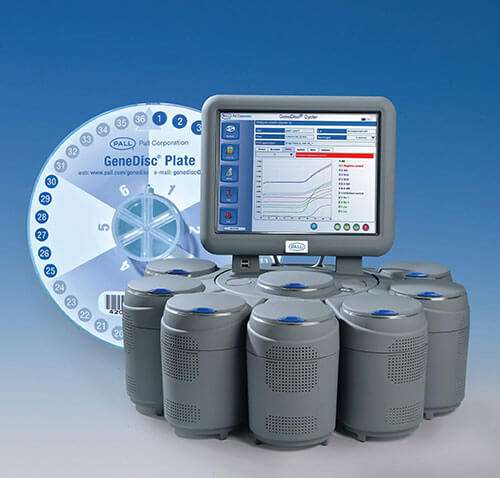クラフトブルワリーは、Pall社のGeneDisc®システムと微生物ろ過により、イメージを保持し、損失を最小限に抑えることができます。
概要
ビールはpHが低く、エタノール濃度が高く、酸素含有量が低いため、細菌の増殖が制限されていますが、ラクトバチルス、ペディオコッカス、ペクチナトゥス、メガスファエラなどの特定のビール腐敗菌の存在は、風味、濁り、酸味を発生させる可能性があります。このような品質の欠陥は、製品を受け入れられないものにし、多くの場合、高い経済的損失と負のブランドイメージをもたらします。製造プロセス全体を通して、最終的に要求されるビールの品質を達成するためには、望ましくない微生物汚染を防止しなければなりません。
機器の清掃や消毒が不十分な場合、問題のある微生物の増殖を可能にし、製品を再感染させ続ける可能性があります。工芸品の醸造技術は、殺菌されていない工芸品のビールのような最小限に処理された製品に対する消費者の嗜好の高まりを満たすことを目指しています。熱処理を行わないことで、ビールの風味や栄養成分のプロファイルがより良く保たれますが、微生物の安定性と保存期間を確保するためには、プロセスの重要なポイントで厳格な微生物管理と効果的な品質モニタリングを維持する必要があります。腐敗が検出された場合、汚染源と微生物の種類を迅速に診断することは、タイムリーな意思決定、是正措置の実施、生産を正常な状態に戻すために最も重要です。
課題
クラフトビール工場は、増加し続ける地域で年間 18,000 ヘクトリットルのビールを出荷しています。製品群は、ダークラガー、ペールラガー、ペールエール、スコットランドエール、季節限定ビールで構成されています。生産プロセスは、複数の発酵槽でのビール製造、遠心分離、簡単な粒子ろ過装置を用いた明るいビールタンクへのセット、ボトルや樽へのパッケージングから構成されています。
ある週末に、発酵開始から 48 時間後と 72 時間後に採取した発酵槽サンプルの寒天培地プレートが、数日間の培養後に汚染を示したという状況が発生しました。進行中の発酵バッチのための最善の処置を決定しながら、原因を特定し、理解するために直ちに調査行動が必要でした。典型的な発酵時間はビールの種類にもよりますが、2~5 週間の範囲であり、バッチの処分を早く決定できれば、醸造所の生産への影響を最小限に抑えながら、新しいバッチを早く開始することが可能になります。残念ながら、手元にある典型的な培養技術では、所見を確認して解釈し、関係する微生物のタイプを特定し、問題を正しく診断するために、さまざまなサンプリングから場所ごとの汚染結果を提供するために、数週間に及ぶ手間と時間のかかるプロセスを必要としていました。
解決策
問題のより迅速な調査を可能にするために、Pall GeneDisc システムが醸造所に提供されました。GeneDisc ラピッド マイクロバイオロジー システムは、リアルタイム PCR (ポリメラーゼ連鎖反応) ベースのプラットフォームで、サンプリング後わずか 2 時間で定性、自動解釈、定義された結果を提供し、必要に応じて濃縮ステップを実行します。このお客様のアプリケーションでは、汚染レベルが低いことが予想されたため、濃縮ステップが実施されました。是正措置を効果的に決定するために、問題のある微生物を特定する必要があったため、GeneDisc PCR システムは貴重なものでした。
2 日間で、発酵槽と酵母スラリーの管理、工場の洗浄 (CIP) とリンス水を含む 18 のサンプルを採取した結果、GeneDisc の結果と詳細な醸造所のウォークスルーを組み合わせることで、微生物の種類と汚染の原因を特定することができました。1つの発酵槽からのサンプルでは、義務的にビールを汚す菌であるラクトバチルス・ブレビスの存在が確認されましたが、他の4つの発酵槽からのサンプルではビールを汚す菌の存在は確認されませんでした。汚染の原因は発酵エリアにある長さ6インチの配管のデッドレッグであることが判明しましたが、これはバッチ間に適切に清掃されていませんでした。この配管は最近、プロセス内のエアースパージングポイントを変更したところに設置されていた。
調査開始から3日目に配管の詳細が修正され、工場管理者が影響を受けたバッチの処分を決定しました。
調査開始から3日目に、配管の細部が修正され、工場管理者は影響を受けたバッチの処分を決定した。ビール以外のスポイラーの衛生指標バクテリアを含むバッチは、Pall Ultipor® N66カートリッジフィルター(AB*NB*BW*)で0.45ミクロンの膜ろ過を行い、ビールを微生物学的に安定した状態にしました。ウルティポールN66膜ろ過液は、ボトリング前の最終ろ過ステップとして実施されました。プリーツナイロンメディアを使用したUltipor N66シングルオープンエンドカートリッジフィルターは、ビールやその他の食品・飲料用途において、信頼性が高く、経済的で効率的な微生物の安定化が可能であることが実証されています。衛生的なFBTフィルターハウジングに取り付けて、ろ過バッチごとに温水またはその場蒸気で繰り返しサニタイズすることができ、長寿命化を実現します。節約されたビールの量は合計で350ヘクトリットル、年間生産量の約2%に相当します。このコスト削減よりもはるかに重要なのは、醸造所が生産量の大半をスケジュール通りに維持できたことです。影響を受けたすべてのバッチをやり直す必要に直面していたとしたら、生産が 2 ヶ月遅れてしまい、顧客への約束の供給が中断され、ネガティブなイメージが生まれていたでしょう。
利点
GeneDisc PCR システムと Ultipor N66 微生物低減フィルターのデュアル ソリューションは、腐敗検出後にこれらの利点を提供しました。
- 汚染源と関係する細菌の種類の迅速で有益かつ信頼性の高い根本原因分析
- 問題の原因を除去し、悪影響を軽減するための迅速な是正措置
- 。/li>
- 明確な結果による迅速な意思決定により、醸造所は重要なバッチを 1 つだけ選択的に廃棄し、通常の操業を迅速に回復することができました。li>ろ過による製品の品質の修正により、醸造所は将来の問題を積極的に排除しながら、生産量の 2% を節約することができました
- 経済的損失を最小限に抑えました
- 工芸品醸造所の評判を維持しました
多くのクラフトビール醸造所では、各醸造所に固有のテスト プログラムを使用して、プロセス全体の診断ツールとして GeneDisc PCR ベースのモニタリングを導入しています。このシステムは、腐敗菌と腐敗酵母の両方を識別するのに適しています。このシステムは、現在実施されている検査プログラム、ハザード分析計画、汚染のトラブルシューティングに適合します。
Pall Corporation について
Pall Corporation は、世界的なろ過、分離、浄化のリーダーであり、ライフ サイエンスや産業界の幅広い分野の顧客の重要な流体管理のニーズを満たすためのソリューションを提供しています。また、お客様と協力して、健康、安全、環境に配慮した技術の向上に努めています。ポールフード&ビバレッジは、飲料・食品製造における製品の品質を確保し、プロセスの信頼性を維持するための製品とサービスを提供しています。また、当社のソリューションは、消費者保護、運用コストの削減、廃棄物の最小化にも役立ちます。




